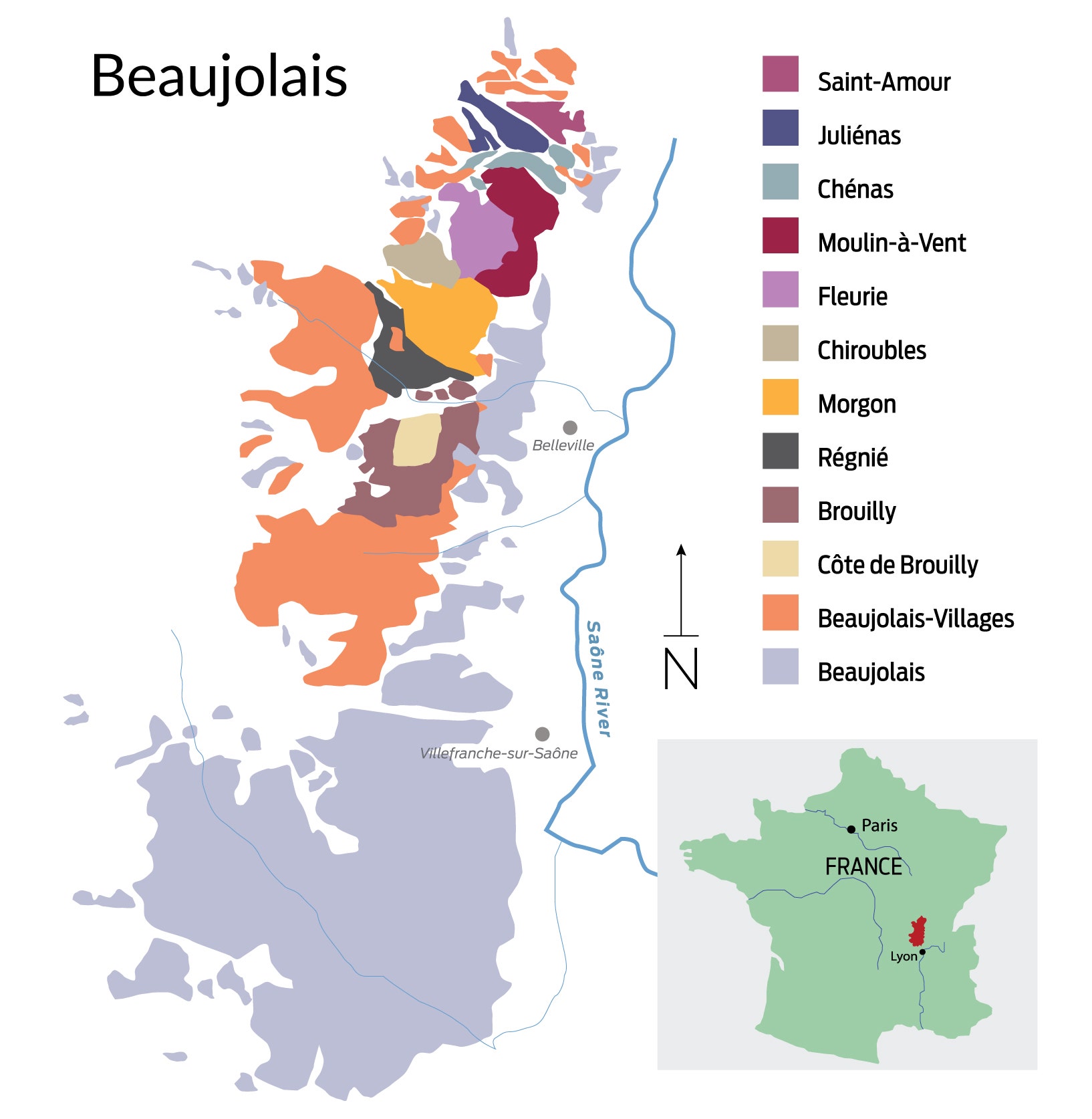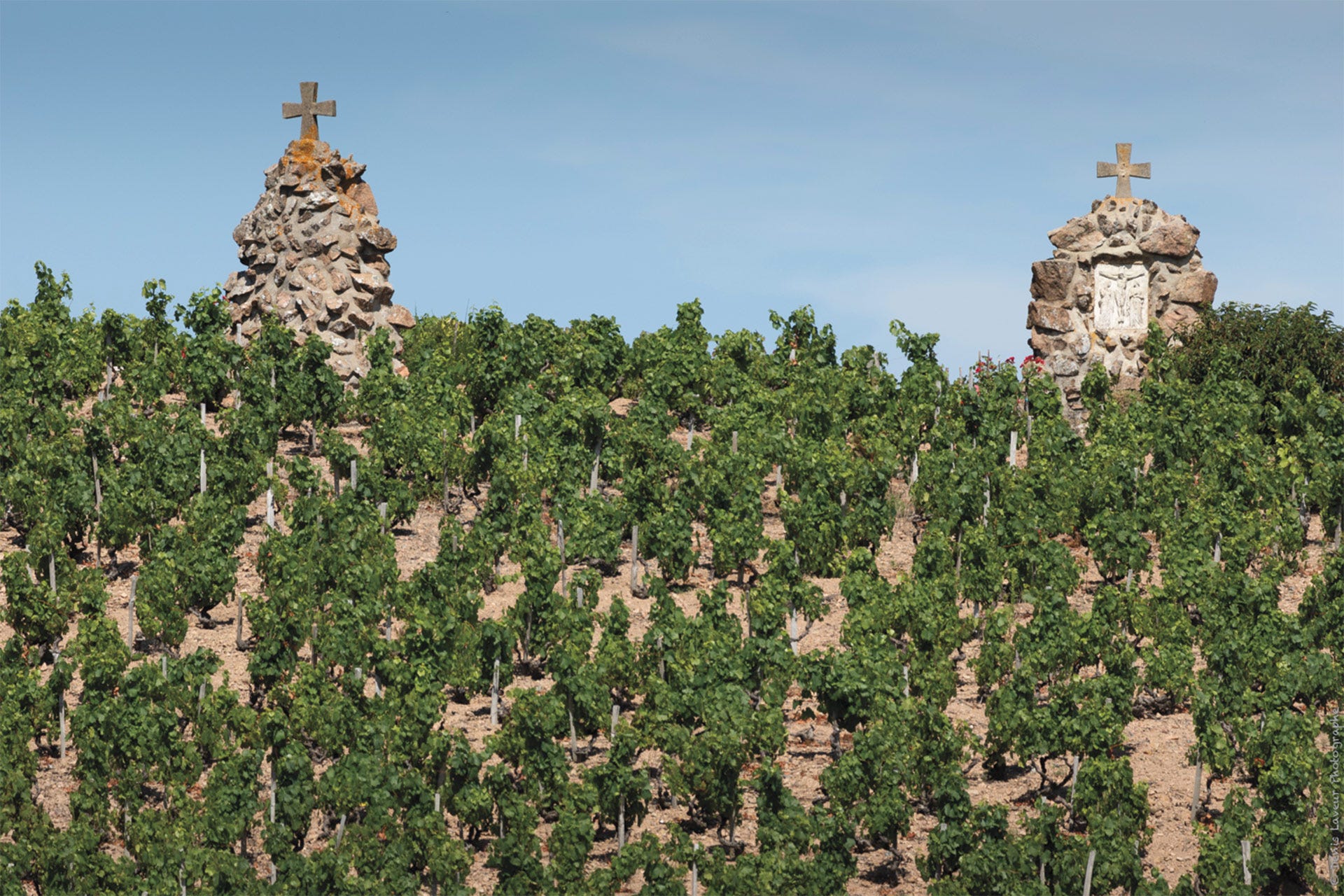Beaujolais is a land of hills, of steep vineyards and of clustered villages. It produces enjoyable and versatile red wines of great value, but don’t mistake this region for a one-trick pony.
An hour north of the city of Lyon, Beaujolais’s spirit is half in the north of France, looking toward Burgundy, and half in the south, with eyes toward the Rhône Valley and Languedoc.
That dichotomy is reflected in the region’s wines.
In the north, there are the ageworthy, always fascinating wines made in the Burgundian fashion and sold under the 10 village appellations of the Beaujolais crus: Saint-Amour, Juliénas, Chénas, Moulin-à-Vent, Fleurie, Chiroubles, Morgon, Régnié, Brouilly and Côte de Brouilly.
In the south, there are easy-drinking wines made with semicarbonic fermentation and sold under the Beaujolais and Beaujolais-Villages appellations.
All are terrific values. Among cru wines from the current vintage, 2018, 125 bottlings were rated 90 points and higher—but don’t hesitate to buy older bottles. Good Beaujolais and Beaujolais Villages, while less ageworthy, are also less expensive.
Beaujolais rocks
There are more contrasts than aspect and designation. The rocks in the north are granite, which is reflected in the area’s architecture and wines. In the south, clay and limestone dominate, creating the beautiful stone that inspired the region to be called Terres Dorées, the golden land.
Then there are the vineyards. The traditional way to plant vines was as bush vines, with each plant in its own universe. It’s hard to manage and harvest, but the many vineyards like this speak to the veneration of the unique heritage of old vines in Beaujolais.
In more modern vineyards, younger vines are planted in rows, trained on wires, easy to control and harvest. All of Beaujolais, even the new plantings, must be harvested by hand.

More Than One Way to Make Wine
Just as there all these dualities to Beaujolais, there are two main ways to produce it: semicarbonic and classic Burgundy. Check out below to learn the technical details; the results are distinct and tailor-made for the region’s two styles.
If you are producing fruity wines to be enjoyed young, then semicarbonic maceration is for you.
If you’re after ageworthy wines, then the Burgundian technique is at hand. An increasing number of influential producers use the latter, as they see the potential that has always been present in Beaujolais.
Other parameters come into play—the terroir, the type of soil, the age of the vines and the way they’re planted in the vineyard.
All those factors come together in the wines. One thing that can be said with certainty: Beaujolais may have just one grape—red Gamay, here since the 14th century—but it’s not one vast, homogenous vineyard. It has many styles; producers have many tools in their backpacks.

Spoiled for Choice
The choice for wine producers is not an “either/or” in Beaujolais. There are plenty of ways to use those Gamay grapes.
Anita Kuhnel of Domaine Anita speaks for many producers when she says, “both winemaking techniques have their place.” While 70% of her wines are made by the Burgundian method, she uses semicarbonic maceration for “wines from my young vines that really don’t lend themselves to aging.”
It’s the old vines, of which she has many, that demand the Burgundian method.
“I want to get the noble tannins from the skins, especially as the berries from old vines are often small and the skins are thick,” she says. These are perfect conditions for wines that can age, like Domaine Anita’s Coeur de Vigneronne.
This choice wasn’t always there. According to Cyril Chirouze, director of Château des Jacques in Romanèche-Thorins, destalking and long macerations were once the norm in Beaujolais, just as they are in Burgundy.
Carbonic maceration, and its adaptation to semicarbonic maceration, are interlopers from Languedoc. There, the technique was used to make quick, inexpensive wine from Carignan and Aramon grapes for field and factory workers.
“It was the creation of Beaujolais Nouveau in the 1950s, which needed to be made and drunk in months,” says Chirouze, that caused semicarbonic maceration to gain its tank-hold in Beaujolais.

Burgundy Drifts South
When it purchased 200-acre Château des Jacques in 1996, négociant Louis Jadot became, by far, the earliest arrival from Burgundy. Ownership of the company was attracted by the possibilities of the Gamay grape and the comparatively inexpensive land, in comparison to Burgundy.
Others have followed, like Albert Bichot at Domaine de Rochegrès in Moulin-à-Vent. The Henriot family, owners of Bouchard Père et Fils in Burgundy, purchased Château de Poncié in Fleurie. Both owners brought Burgundian know-how and produce wines with that influence at the fore.
Other Burgundians went for larger buys: Louis Latour at négociant Henry Fessy and the Boisset family at négociant Mommessin. Both companies continue to make Beaujolais for early consumption using semicarbonic maceration. Mommessin launched a range of wines called Les Mises, using Burgundian techniques.
Lydie Nesme, the Mommessin winemaker, says she’s “100% Beaujolais” from a family that has grown grapes “for generations.” With Les Mises, she selects parcels of vines from the crus of Saint-Amour, Moulin-à-Vent and Côte de Brouilly, as well as two from Morgon, Côte de Py and Les Charmes. Her approach shows the flexibility possible in Beaujolais.
“We choose the type of vinification depending on the parcel,” she says. “For example, Morgon Côte de Py, which comes from black granite soil, is half Burgundy-style and half semicarbonic. Côte de Brouilly, whose rocks are volcanic, is made entirely with the Burgundian technique. Saint-Amour, with its chalk and granite mix, is semicarbonic.”

The Effects of Aging
Nesme points out the effects of each technique on the wines’ aging potential. “The semicarbonic vinification means the wines can age a maximum of five years. With Burgundian, it’s five to 10.”
Pascal Aufranc in Juliénas and Chénas also had aging on his mind when he created his Burgundian-style Chénas Naturellement, bottled without added sulfur.
“It allowed me to have more aromatic fruit, while the higher acidity gives the wine aging potential,” he says.
Aufranc echoes other producers when he says that there’s so much flexibility in Beaujolais today.
“Both types of vinification have their place in Beaujolais,” he says. “The range of wines and their styles is so large today, it opens up so many possibilities.”
For his other cuvées, Aufranc uses semicarbonic maceration. He says that “this can bring out more of my terroir, especially the floral aromas of the granite that defines my vineyards.”
Beaujolais is enjoying a renaissance. It has emerged from the era of industrial wine. There’s a return to origins and a greater understanding of the possibilities to reflect the varied terroirs.
And to hand, they have a grape, Gamay, that lends itself to so many interpretations. Charlene Denis is sales manager of Château de Chatelard, which is owned by the Duboeuf family, but operated independently. She describes Gamay as a “grape that is so versatile, able to be vinified in so many different ways, able to give wines that have totally different profiles.”
It’s an exciting time to be a Beaujolais producer. And it’s an exciting time to explore all the tastes that this beautiful region can offer.

The difference between carbonic and semicarbonic maceration
Learn the difference between semicarbonic maceration and the Burgundian technique.
Carbonic maceration is the result of a carbon dioxide-rich atmosphere inside a closed container. The grapes start to ferment spontaneously from the inside out. The end product is a softly textured wine that’s ready to drink while still young. Call it whole-grape fermentation.
Semicarbonic maceration, the technique used in Beaujolais, involves fermentation that starts in closed containers, like carbonic maceration. The wine is then transferred to traditional fermentation vats and yeast is added to continue the process. While some of the wines will go into wood, many will continue to age in tanks, which highlight the fruit and lower the tannins.
Carbonic maceration is not a new technique. It occurs naturally when grapes are put in a closed jar or container. But it was Jules Chauvet, a wine négociant and chemist who worked in the region after World War II, who developed the semicarbonic technique for Beaujolais Nouveau to be consumed as soon as possible after harvest.
The Burgundian technique is very different. Grapes are destalked and crushed before fermentation. That opens the fruit up and brings out the tannins that will allow the wine to age. Only then does fermentation start, either through natural yeasts on the grape skins or from added yeasts. In most cases, wines made this way in Beaujolais will also have wood aging.
Explore the Versatility
Here are three wines made by semicarbonic maceration:
Clos des Quatre Vents 2018 Fleurie; $24, 91 points. From a family-owned estate that is managed by Georges Duboeuf, this wine shows a good structure as well as ripe fruit. Tannins give weight and backbone to a wine that could well age. Drink from late 2020. Quintessential Wines.
Robert Perroud 2018 L’Enfer des Balloquets (Brouilly); $20, 91 points. Historically known as l’enfer, or hell, this sheltered vineyard is hand-harvested on a 40% slope. The resulting wine is ripe and smoothly textured. This vintage has spice and the potential of black fruits that will come out strongly as the wine matures. Drink from 2021. American B.D.
Vignerons de Bel-Air 2018 Beaujolais-Villages; $13, 88 points. This is a structured wine, with some firm tannins as well as ripe berry fruits. Freshness comes from bright acidity that shines easily through the concentration from the old vines. Drink now.Cuvée Imports. Best Buy.
And three made the Burgundian way:
Château des Jacques 2017 Clos des Rochegrès (Moulin-à-Vent); $38, 94 points. This wood-aged wine comes from 45-year-old vines in one of the top vineyards in the appellation. Rich and beautifully structured, it has tannins and a firm structure that point to aging. Wait to drink this wine until 2022. Kobrand. Cellar Selection.
Domaines Dominique Piron 2017 Côte du Py (Morgon); $30, 94 points. From one of the top producers in Morgon, this bottling combines great terroir and old vines to give a wine that has so much structure. The dry core is still keeping the fruit in check, waiting to let it burst out in blackberry glory. Let this wine age and drink from 2022. Baron Francois. Cellar Selection.
Jean Loron 2018 Château de Fleurie (Fleurie); $24, 92 points. From vines around an 18th-century chateau in the village of Fleurie, this wine is structured and packed with ripe fruit. It has that poise between perfumed fruit and tannins that marks this appellation. Drink this wine from 2021. David Bowler Wine. Editors’ Choice.
Last Updated: May 8, 2023















